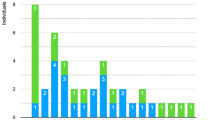Abstract
In the management of craniosynostosis, there is a need for quantitative assessment of treatment methods and outcome. Radiology and pressure studies are well documented, but so far little attention has been given to cerebral blood flow changes and their possible relevance. This paper reports our initial experience using transcranial Doppler sonography to calculate the cerebrovascular resistance and cerebral blood velocities in the major basal vessels before and after surgery for craniosynostosis. Ten patients were studied using the Scimed 2-MHz probe through the temporal and frontal “windows” of the skull. Measurements were taken under standard physiological conditions before, during and after surgery. Preliminary results suggest that this non-invasive technique may be helpful in predicting and assessing the outcome following surgery for craniosynostosis.
Similar content being viewed by others
References
Aaslid R, Markwalder TM, Nornes H (1982) Noninvasive transcranial doppler recordings of flow velocity in basal cerebral arteries. J Neurosurg 57: 769–774
Bernhard JA, Von Reuterin GM (1986) Transcranial doppler sonography; examination technique and normal reference values. Ultrasound Med Biol 12:115–123
Bode H (1988) Pediatric applications of transcranial doppler sonography. Springer, Vienna New York
David JD, Poswillo D, Simpson D (1982) The craniosynostoses. Springer, Berlin Heidelberg New York
Gellad FE, Haney PJ, Sun JC, Robinson WL, Rao KC, Johnston GS (1985) Imaging modalities of craniosynostosis with surgical and pathological correlation. Pediatr Radiol 15: 285–290
Harders A (1986) Neurosurgical applications of transcranial doppler sonography. Springer, Vienna New York
Marchac D, Renier D (1989) Craniosynostosis. World J Surg 13:358–365
Marchac D, Renier D (1990) New aspects of craniofacial surgery. World J Surg 14:725–732
Renier D, Marchac D (1987) Intracranial pressure recordings: analysis of 302 cases. In: Marchac D (ed) Craniofacial surgery. Proceedings of the 1st International Congress of Cranio-Maxillo-Facial Surgery. Springer, Berlin Heidelberg New York, pp 110–117
Ringelstein EB (1988) A practical guide to transcranial doppler sonography. In: Weinberger J (ed) Noninvasive assessment of cerebral circulation in cerebrovascular disease. (Frontiers of clinical neuroscience series) Liss, New York, pp 75–121
Satoh M, Ishikawa N, Enomoto T, Takeda T, Yoshizawa T, Nose T (1990) Study by 123-IMP-SPECT before and after surgery for craniosynostosis. Kaku Igaku 27:1411–1418
Shirane R, Sato S, Sato K Kameyama M, Ogawa A, Yoshimoto T, Hatazawa J, Ito M (1992) Cerebral blood flow and oxygen metabolism in infants with hydrocephalus. Child's Nerv Syst 8:118–123
Author information
Authors and Affiliations
Rights and permissions
About this article
Cite this article
Iqbal, J.B., Hockley, A.D., Wake, M.J.C. et al. Transcranial Doppler sonography in craniosynostosis. Child's Nerv Syst 10, 259–263 (1994). https://doi.org/10.1007/BF00301165
Received:
Issue Date:
DOI: https://doi.org/10.1007/BF00301165




